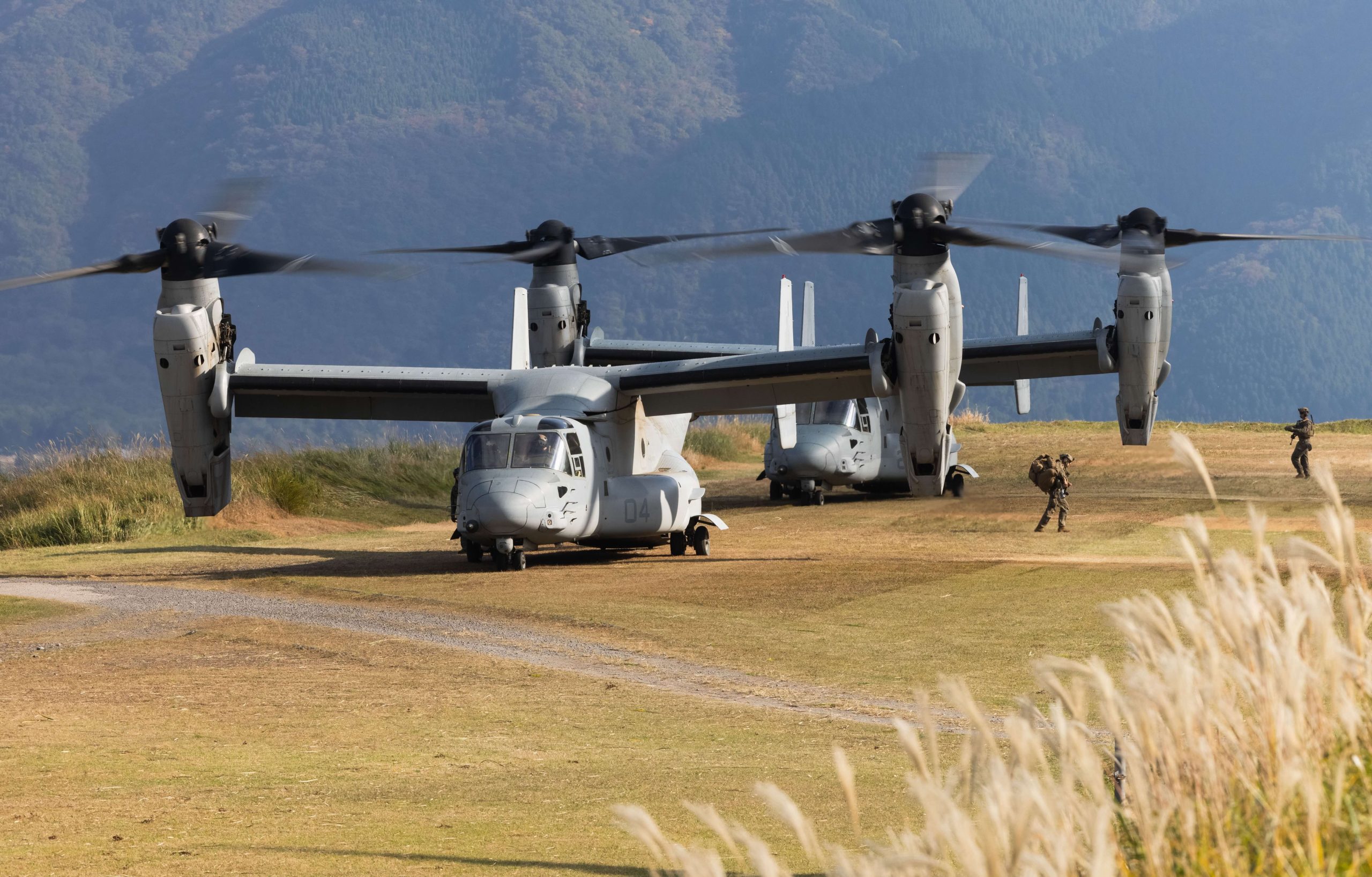
Top Japanese government officials have expressed concern that the United States is not providing sufficient information regarding the ongoing flights of U.S. Ospreys in Japan following Wednesday’s crash of an Air Force Special Operations (AFSOC) CV-22 in the waters of Yakushima Island. Meanwhile, the Carl Vinson Carrier Strike Group (CSG) wrapped up drills with a Japan Maritime Self-Defense Force destroyer on Thursday.
On Friday, during his daily morning press conference, Japan’s Chief Cabinet Secretary Hirokazu Matsuno stated that, despite requests by the Japanese government, there has not been sufficient explanation by the United States regarding the safety of the Osprey helicopters and flight operations. “We have concerns about what is going on,” Matsuno stated.
Matsuno reiterated that the Japanese government had sent an official notification to the U.S. government asking to halt Osprey flights in Japan save for search-and-rescue (SAR) operations until the U.S. can confirm the safety of the aircraft. During a Thursday press briefing, Pentagon Deputy Press Secretary Sabrina Singh stated that the Pentagon had not received an official request from Japan, and that the U.S. was continuing to operate the Osprey aircraft while they investigated the mishap.
In a Friday media release Singh stated that the safety of U.S. service members and Japanese communities is a top priority and the U.S. is taking all appropriate safety measures. “The unit of the CV-22 that had the accident is not conducting flight operations. All V22 Ospreys in Japan operate only after undergoing thorough maintenance and safety checks.” She added that the U.S has already started sharing information with Japan and has pledged to continue to do so in a timely and transparent manner.
Japan’s Defense Minister Minoru Kihara has expressed concerns “about the fact that the Osprey has been flying without sufficient explanation of flight safety confirmation, despite repeated requests by the Government of Japan.” Earlier in the press conference, Kihara told the media that the U.S. military had informed him that no CV-22 flights were being conducted that day, but that the U.S. military would continue flying Ospreys deployed in Japan, which are flown only after thorough and careful maintenance and safety inspections. He also said he’d received a detailed brief from the U.S. regarding the accident.
On Thursday at 5.30 p.m Kihara met the commander of U.S. Forces Japan, Lt. Gen. Ricky N. Rupp, at Japan’s Ministry of Defense, where he conveyed Japan’s request on Osprey operations. In Friday’s press conference, Kihara stated that he did not think that the information he received from the U.S. that morning was sufficient and he will continue to work with Rupp on the matter.
Kihara also provided details on U.S military Osprey flights that have been conducted since Wednesday’s accident, stating that Marine Corps MV-22Bs had conducted 46 take-offs and landings at MCAS Futenma, Okinawa, and six take-offs and landings at Kadena Air Base, Okinawa, while Navy CMV-22 Ospreys had conducted six take-offs and landings at Kadena. The Navy currently has a detachment from Fleet Logistics Multi-Mission Squadron (VRM) 30 deployed with carrier USS Carl Vinson (CVN-70), which is operating in the Philippine Sea.
Japan grounded its 14 V-22Bs Ospreys operated by the Japan Ground Self-Defense Force (JGSDF) following Wednesday’s accident. A planned capability demonstration at Saga Airport, Kyushu, over the weekend has been canceled because of local concerns, stated Kihara in a Thursday press conference following his meeting with Rupp. The JGSDF plans to deploy its V-22Bs at Saga Airport in 2025 as part of Japan’s plans to strengthen the defense of its southwest islands. A total of 17 V-22Bs were ordered by Japan in 2015 with three more to be delivered.
On Friday, an AFSOC update on the crash stated that the U.S. military, alongside the Japan Coast Guard, Japanese Self-Defense Forces, local law enforcement and Japanese civilian volunteers, is continuing SAR operations for the CV-22 crew. The release also stated that seven airmen are in DUSTWUN (duty status whereabouts unknown) and confirmed that one set of remains has been recovered. The release also stated that units carrying out the SAR were the Japan Coast Guard (JCG), Japanese Self-Defense Forces (JSDF), Pacific Air Forces (PACAF), Pacific Fleet (PACFLT), Marine Corps Forces, Pacific (MARFORPAC), Special Operations Command Pacific (SOCPAC), 353rd Special Operations Wing, Kadena Air Base, Japan, 18th Wing, Kadena Air Base, Japan, and 1st Special Forces Group.
In Friday’s report on the SAR operations, Japan’s Joint Staff Office (JSO) stated that destroyer JS Kirisame (DD-104) has joined the eight other JMSDF ships searching the waters off Yakushima. The other eight JMSDF ships are destroyer escort JS Tone (DE-234), frigates JS Noshiro (FFM-3) and JS Mikuma (FFM-4), mine countermeasures vessel JS Uraga (MST-463), minesweepers JS Takashima (MSC-603), JS Toyoshima (MSC-685) and JS Miyajima (MSC-690) and fast-attack craft JS Shirataka (PG-829). The JSO also reported that Tone lifted and collected parts believed to be from the CV-22B that were discovered by the Japan Coast Guard. Flight operations for the day were carried out by two Japan Air Self-Defense Force (JASDF) U-125 SAR aircraft and four JASDF UH-60J SAR helicopters, while ground searches around Yakushima’s coastline were carried out by a hundred JGSDF personnel and one drone, according to the report.
On Thursday, the Carl Vinson CSG wrapped up drills with Kirisame that began from Tuesday that took place from the East China Sea to south of Okinawa, according to a JMSDF release. The Carl Vinson CSG consisted of carrier Carl Vinson together with destroyers USS Kidd (DDG-100) and USS Sterett (DDG-104). Also participating in the drills, which consisted of tactical exercises and replenishment at sea exercises, were dry cargo ship USNS Charles Drew (T-AKE-10) and fleet oiler USNS Yukon (T-AO-202). Earlier on Monday, the CSG and Kirisame, together with Republic of Korea Navy (ROKN) destroyer ROKS Sejong the Great (DDG-991), carried out a trilateral deterrence drill against North Korea.





